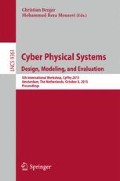Abstract
Battery powered systems are a major area of cyber physical system innovation. This paper develops a kinetic battery model with bounded capacity in the context of piecewise constant yet random charging and discharging. The resulting model enables a faithful time-dependent evaluation of the risk of a mission failure due to battery depletion. This is exemplified in a power dependability study of a nano satellite mission currently in orbit.
Access this chapter
Tax calculation will be finalised at checkout
Purchases are for personal use only
References
Abate, A., Prandini, M., Lygeros, J., Sastry, S.: Probabilistic reachability and safety for controlled discrete time stochastic hybrid systems. Automatica 44(11), 2724–2734 (2008)
Altman, E., Gaitsgory, V.: Asymptotic optimization of a nonlinear hybrid system governed by a markov decision process. SIAM J. Control Optim. 35(6), 2070–2085 (1997)
Aydin, H., Mejía-Alvarez, P., Mossé, D., Melhem, R.G.: Dynamic and aggressive scheduling techniques for power-aware real-time systems. IEEE RTSS 2001, 95–105 (2001)
Blom, H.A., Lygeros, J., Everdij, M., Loizou, S., Kyriakopoulos, K.: Stochastic Hybrid Systems: Theory and Safety Critical Applications. LNCS, vol. 337. Springer, Heidelberg (2006)
Boker, U., Henzinger, T.A., Radhakrishna, A.: Battery transition systems. In: POPL, pp. 595–606. ACM (2014)
Bujorianu, M.L., Lygeros, J., Bujorianu, M.C.: Bisimulation for general stochastic hybrid systems. In: Morari, M., Thiele, L. (eds.) HSCC 2005. LNCS, vol. 3414, pp. 198–214. Springer, Heidelberg (2005)
Cao, J., Schofield, N., Emadi, A.: Battery balancing methods: a comprehensive review. In: Vehicle Power and Propulsion Conference, VPPC 2008, pp. 1–6. IEEE, September 2008
Cloth, L., Jongerden, M.R., Haverkort, B.R.: Computing battery lifetime distributions. In: DSN, pp. 780–789. IEEE Computer Society (2007)
Corless, R.M., Gonnet, G.H., Hare, D.E.G., Jeffrey, D.J., Knuth, D.E.: On the lambertW function. Adv. Comput. Math. 5(1), 329–359 (1996)
Davis, M.H.: Piecewise-deterministic markov processes: a general class of non-diffusion stochastic models. J. Roy. Stat. Soc. Ser. B (Methodol.) 46, 353–388 (1984)
Esa: Esa cubesat program, October 2014. http://www.esa.int/Education/CubeSats
Soudjani, S.E.Z., Gevaerts, C., Abate, A.: Faust2: formal abstractions of uncountable-state stochastic processes. In: Baier, C., Tinelli, C. (eds.) TACAS 2015. LNCS, vol. 9035, pp. 272–286. Springer, Heidelberg (2015)
Fox, M., Long, D., Magazzeni, D.: Automatic construction of efficient multiple battery usage policies. In: Walsh, T. (ed.) IJCAI, pp. 2620–2625. IJCAI/AAAI (2011)
Fränzle, M., Hahn, E.M., Hermanns, H., Wolovick, N., Zhang, L.: Measurability and safety verification for stochastic hybrid systems. In: HSCC, pp. 43–52. ACM Press, New York, NY, USA (2011)
Fränzle, M., Hermanns, H., Teige, T.: Stochastic satisfiability modulo theory: a novel technique for the analysis of probabilistic hybrid systems. In: Egerstedt, M., Mishra, B. (eds.) HSCC 2008. LNCS, vol. 4981, pp. 172–186. Springer, Heidelberg (2008)
Gilles, P.: Private communication (2014)
Gillespie, D.T.: A general method for numerically simulating the stochastic time evolution of coupled chemical reactions. J. Comput. Phys. 22(4), 403–434 (1976)
GomSpace: Gomspace gomx-1, October 2014. http://gomspace.com/?p=gomx1
Henzinger, T.A.: The theory of hybrid automata. In: Kemal Inan, M., Kurshan, R.P. (eds.) Verification of Digital and Hybrid Systems. NATO ASI Series, vol. 170, pp. 265–292. Springer, Heidelberg (2000)
Henzinger, T.A., Sifakis, J.: The embedded systems design challenge. In: Misra, J., Nipkow, T., Sekerinski, E. (eds.) FM 2006. LNCS, vol. 4085, pp. 1–15. Springer, Heidelberg (2006)
Hermanns, H., Krcál, J., Nies, G.: Recharging probably keeps batteries alive. CoRR abs/1502.07120 (2015)
Jongerden, M., Haverkort, B., Bohnenkamp, H., Katoen, J.: Maximizing system lifetime by battery scheduling. In: DSN, pp. 63–72. IEEE (2009)
Jongerden, M.R., Haverkort, B.R.: Which battery model to use? IET Softw. 3(6), 445–457 (2009)
Jongerden, M.R.: Model-based energy analysis of battery powered systems. Ph.d. thesis, Enschede, December 2010
Liaw, B.Y., Roth, E.P., Jungst, R.G., Nagasubramanian, G., Case, H.L., Doughty, D.H.: Correlation of arrhenius behaviors in power and capacity fades with cell impedance and heat generation in cylindrical lithium-ion cells. J. Power Sources 119, 874–886 (2003)
Liu, J., Chou, P.H., Bagherzadeh, N., Kurdahi, F.: Power-aware scheduling under timing constraints for mission-critical embedded systems. In: DAC, pp. 840–845. ACM, New York, NY, USA (2001)
Manwell, J.F., McGowan, J.G.: Lead acid battery storage model for hybrid energy systems. Sol. Energy 50(5), 399–405 (1993)
Rao, V., Singhal, G., Kumar, A., Navet, N.: Battery model for embedded systems. In: VLSI Design/ES Design, pp. 105–110. IEEE (2005)
SENSATION: Sensation, March 2015. http://www.sensation-project.eu/
Sproston, J.: Decidable model checking of probabilistic hybrid automata. In: Joseph, M. (ed.) FTRTFT 2000. LNCS, vol. 1926, p. 31. Springer, Heidelberg (2000)
Villén-Altamirano, M., Villén-Altamirano, J.: Restart: a straightforward method for fast simulation of rare events. In: WSC, pp. 282–289. IEEE (1994)
Wognsen, E.R., Hansen, R.R., Larsen, K.G.: Battery-aware scheduling of mixed criticality systems. In: Margaria, T., Steffen, B. (eds.) ISoLA 2014, Part II. LNCS, vol. 8803, pp. 208–222. Springer, Heidelberg (2014)
Zhang, L., She, Z., Ratschan, S., Hermanns, H., Hahn, E.M.: Safety verification for probabilistic hybrid systems. In: Touili, T., Cook, B., Jackson, P. (eds.) CAV 2010. LNCS, vol. 6174, pp. 196–211. Springer, Heidelberg (2010)
Acknowledgements
The authors are grateful for inspiring discussions with Peter Bak and Morten Bisgaard (GomSpace ApS), Erik R. Wognsen (Aalborg University), and other members of the SENSATION consortium, as well as with Pascal Gilles (ESA Centre for Earth Observation), Xavier Bossoreille (Deutsches Zentrum für Luft- und Raumfahrt) and Marc Bouissou (Électricité de France S.A., École Centrale Paris - LGI).
This work is supported by the EU 7th Framework Programme under grant agreements 295261 (MEALS) and 318490 (SENSATION), by the DFG as part of SFB/TR 14 AVACS, by the Czech Science Foundation under grant agreement P202/12/G061, by the CAS/SAFEA International Partnership Program for Creative Research Teams, and by the CDZ project CAP (GZ 1023).
Author information
Authors and Affiliations
Corresponding author
Editor information
Editors and Affiliations
Rights and permissions
Copyright information
© 2015 Springer International Publishing Switzerland
About this paper
Cite this paper
Hermanns, H., Krčál, J., Nies, G. (2015). Recharging Probably Keeps Batteries Alive. In: Mousavi, M., Berger, C. (eds) Cyber Physical Systems. Design, Modeling, and Evaluation. CyPhy 2015. Lecture Notes in Computer Science(), vol 9361. Springer, Cham. https://doi.org/10.1007/978-3-319-25141-7_7
Download citation
DOI: https://doi.org/10.1007/978-3-319-25141-7_7
Published:
Publisher Name: Springer, Cham
Print ISBN: 978-3-319-25140-0
Online ISBN: 978-3-319-25141-7
eBook Packages: Computer ScienceComputer Science (R0)

